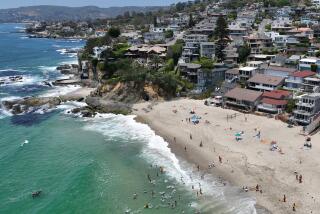WHERE THE DANCE MEETS THE SURF AT OCEAN PARK
Surfers and sun worshipers beware! When Mary Jane Eisenberg’s dance company, Shale, performs her new “Boundary Waters” on the Ocean Park beach (near Ocean Park Boulevard and Barnard Way) at 3 p.m. Saturday, Eisenberg warns that her audience of cruisers and sunburned bruisers may be the essential art spectacle and she the bemused audience member.
Sure, Bruce Fowler’s Trombone Band, which will accompany the dancers as they travel north from lifeguard station No. 26 to No. 24, blasting out sailor songs and Beach Boy riffs, “will make quite a scene,” Eisenberg boasts.
“But so will the unsuspecting sleeping beauties,” the spunky choreographer, 35, says, conjuring up in her imagination a bevy of basking masses roused out of restorative seaside slumber by musicians and dancers warming up.
Are arabesques and lifts near the surf any more or less a staged spectacle than the parade of half-naked bodies sashaying up and down by the water’s edge?
Eisenberg thinks not. Staging what she calls “environmental work designed to be taken out of the dance studio and placed in the world” forces her to confront what she sees as the already blurry distinction between artifice and actuality.
“ ‘Boundary Waters’ isn’t just fun and games,” the choreographer warns, dismissing the idea that the performers would be more effective as social commentary if they actually represented typical beach habitues. Indeed, she did want some distinction between the performers and beachgoers, and for this reason costumed the former in black bathing attire.
It’s not unusual for artists to view aspects of life as “spectacle”--representations, signs, or, as Eisenberg puts it, “pictures you have in your mind about yourself and your world.” But it’s another matter to test this controversial perception on public grounds.
In New York (where Eisenberg lived and studied modern dance in the ‘70s with Louis Falco and Jennifer Muller before establishing Shale in Los Angeles in 1980), street performance was commonplace. Not far from Wall Street, a stretch of sand on the Hudson called Art on the Beach once provided the perfect summer venue for performers interested in applying a rather sandy choreographic touch to the existing sculpture garden.
Art on the Beach’s days are over (condos will soon replace dancers) and Eisenberg points out that “Boundary Waters” really differs from that New York tradition, because “you had to pay to go to Art on the Beach; it was formal.” And the spectator didn’t have to move from place to place.
In 1981, Eisenberg staged a dance-theater work at Los Angeles’ Union Station. In that piece, as well as in “Boundary Waters,” she was challenged to work within existing public arenas to fashion spectacles within spectacles.
“I’m interested more and more in real dance issues and less and less in characters and stories,” Eisenberg reveals. “I may even decide not to dance in this piece, just to watch. Different worlds will meet there. It’ll be a blast to see.”
“Boundary Waters” refers to the “real” boundaries between the United States and Canada, uncharted and mysterious territory to Eisenberg (who grew up on Lake Erie and sailed the Great Lakes with her father). She now feels that her own painful breakup with eight members of her dance company last year, combined with her recent break with narrative structures, makes “Boundary Waters” emblematic of the uncharted deep waters she’s sailing in.
“I juxtapose,” the choreographer concludes, wary of too much philosophizing. “And that’s exactly what I’m doing on the beach. Bodies and minds. Pictures and actions. Art and life.” It’s Eisenberg’s hope that the beach will seem ever more vibrant to Saturday’s beachgoers getting an artistic diversion, and that her dancers, heightened too, will feel the strength of their craft as they dance along the boundary waters of Ocean Park.
More to Read
The biggest entertainment stories
Get our big stories about Hollywood, film, television, music, arts, culture and more right in your inbox as soon as they publish.
You may occasionally receive promotional content from the Los Angeles Times.










